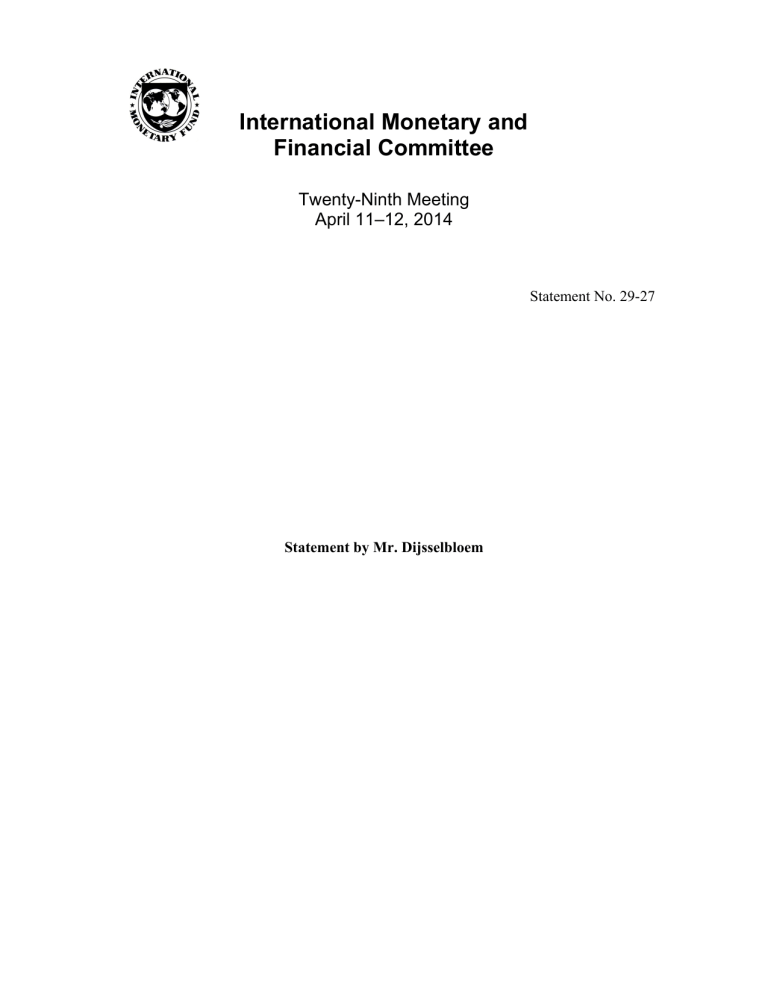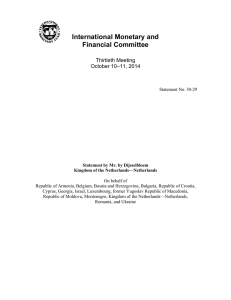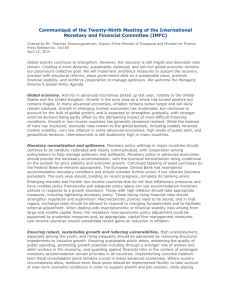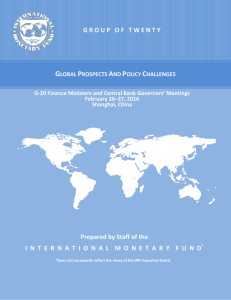International Monetary and Financial Committee

International Monetary and
Financial Committee
Twenty-Ninth Meeting
April 11–12, 2014
Statement No. 29-27
Statement by Mr. Dijsselbloem
Statement by Mr. Jeroen Dijsselbloem
Minister of Finance, The Netherlands on behalf of
Armenia, Belgium, Bosnia and Herzegovina, Bulgaria, Croatia, Cyprus, Georgia, Israel,
Luxembourg, Former Yugoslav Republic of Macedonia, Moldova, Montenegro, The
Netherlands, Romania and Ukraine
At the 29th International Monetary and Financial Committee
Washington DC, April 11-12, 2014
International financial and economic situation and policy priorities
Green shoots brighten up these Spring meetings. The global recovery is confirmed by healthier growth numbers. Although the recovery is still fragile and risks remain, we are increasingly optimistic that the remnants of the 2008 financial crisis and its severe global impact are finally fading.
But important challenges remain. Over the next few years advanced economies need to transition from extraordinary monetary accommodation and ample liquidity conditions to an environment of self-sustained growth. Structural and financial sector reforms, as well as further containing debt dynamics, will have to set economies on a sustainable growth path that is beneficial to all.
Advanced economies are also in a position to support global growth, as China and other emerging market economies – which have kept the world economy going over the last few years – are facing tightening financial conditions and other headwinds to growth. With implementation of a balanced policy mix the latter will continue to have ample opportunities to contribute to – and benefit from – stronger global growth.
Advanced economies
The ongoing recovery of the US economy, including the associated first steps towards normalization of monetary policy, is a positive development. The main challenge is to manage a smooth exit from accommodative monetary policies. Unwinding the unprecedented unconventional monetary measures is uncharted territory. At the same time, new risks and imbalances can materialize in the global and national financial systems if monetary policy is too loose for too long. Sound implementation and communication of the exit is essential to prevent unnecessary volatility in international financial markets.
Japan’s endeavors to fundamentally change its economic policy mix (“Abenomics”) have yielded impressive results. However, the upcoming historic consumption tax hike will be the biggest challenge yet. Bold and effective structural reforms are necessary to unleash sustainable growth and counteract potential erosion in consumer demand following the hike.
While we welcome initial steps on the supply side, for example in agriculture, progress is needed on a wider range of reforms.
In the euro area, three main areas are key to sustainable growth: i) a resilient banking sector that supports the economy, ii) structural reforms and iii) sustainable debt levels.
The establishment of the banking union underpins sustainable growth by strengthening balance sheets, ending financial fragmentation and restoring credit flows. Over the past year,
2 policy makers have agreed on an unprecedented set of measures to improve the resilience and health of the euro area banking sector. The banking union will contribute to breaking the toxic feedback loops between bank balance sheets and sovereign solvency. The Single Supervisory
Mechanism will secure thorough and independent supervision. The Single Resolution
Mechanism and the Single Resolution Fund, will enhance orderly bank resolution in support of financial stability while minimizing the risks to the tax payer, as the Bank Recovery and
Resolution Directive ensures bail-in of shareholders and creditors in case of bank resolution.
The ECB’s ‘comprehensive assessment’ of the largest banks will contribute to bank balance sheet repair and enhance banks’ capacity to extend credit. This will be positive for euro areawide credit conditions.
Structural reforms should be stepped up. Given high unemployment, rising inequality and the risk of prolonged stagnation, concrete measures are needed to allocate idle resources to their most productive use. The functioning of the labor market must be reformed to enhance both demand and supply. Closed professions and services markets should be reformed to enhance competition. Regulatory hurdles should be lowered.
Progress in achieving fiscal sustainability should be preserved. In 2014-2015, most euro area countries will see their debt levels stabilized and structural deficits reduced. Yet debt levels remain historically high. Notwithstanding the prospects of shrinking risk premia and low interest rates over a longer period, complacency on debt sustainability should be avoided. At the same time, reducing debt levels should happen in growth-friendly manner. In this regard the recent shift in fiscal adjustment measures by reducing expenditures rather than by raising new taxes is welcome, as well as tax reform that removes undue distortion. Shifting the tax burden away from labor would support employment and competiveness.
The current bout of low inflation in the euro area follows structural reforms, increased competitiveness, low demand due to balance sheet repair, lower commodity prices and exchange rate developments. Although inflation is projected to be low for a prolonged period, inflation expectations for the euro area over the medium to long term continue to be firmly anchored in line with the ECB’s inflation target of below, but close to, 2%. The ECB has therefore maintained its very accommodative monetary stance and reiterated its forward guidance, while refraining from additional policy measures at the current juncture.
Emerging market economies
While China’s relatively closed financial system and large stock of reserves might help to contain the risk and spillovers of a domestic financial shock, IMF calculations show that a larger than expected slowdown in Chinese growth would substantially impact growth in advanced economies and emerging market economies alike. The reliance on credit-driven investment, including through the non-banking financial sector is a worrying vulnerability. In order to prevent sharp corrections and volatility a gradual shift to a more sustainable Chinese growth model is important. The financial sector reform package proposed by the Chinese authorities is a welcome step.
Other emerging market economies face various challenges. Tightening financial conditions and a more critical investor base point at two key issues.
Macro-economic policies must be recalibrated. Several economies have not yet sufficiently withdrawn their expansive monetary and fiscal policy stance after the financial crisis. Real interest rates have been persistently negative in many countries, while budget deficits have
3 increased. Over the last year markets have become increasingly concerned about such imbalances. In this context we welcome the credible actions that some emerging market economies, including for example India and Indonesia, have already taken.
Structural reforms remain important for emerging market economies. The IMF convincingly shows that domestic factors have played a large role in the slowdown in emerging economies over the last two years. Supply bottlenecks constrain growth expectations. Structural reforms are essential to increase growth potential and ward off negative market sentiment over a longer period.
Low-income countries
Over the last decade, low-income countries have succeeded in maintaining strong growth.
This reflects more favorable business and investment regimes, better macro-economic policies and favorable external circumstances.
While forecasted growth for this group remains strong we see two main challenges. Lower commodity prices should not imperil the conservative budgetary policies that have brought stability to low-income economies. With improved policies, several low- income countries have gained access to international capital markets. Those countries should adjust their macro policy mix to the changing external environment in a timely manner. In some of these countries public debt is rapidly growing because of increased current spending, as opposed to investment in productive public infrastructure. Those countries must constrain expenditure growth and make expenditures more efficient.
IMF Policy Issues
Surveillance
Fund surveillance has undergone important reforms in the past five years to achieve better alignment with the changing nature of the international monetary and financial system. The
Integrated Surveillance Decision (ISD) and Financial Surveillance Strategy (FSS) are key milestones. We value staff’s candid analysis and advice during Article IV consultations and the Financial Sector Assessment Program (FSAP), including through last year’s watershed
EU FSAP. In the months ahead, we look forward to the 2014 Triennial Surveillance Review
(TSR) and the opportunity to thoroughly assess progress on interconnectedness, risk assessment, financial stability, external stability and traction. We encourage the Fund to pay particular attention to financial sector surveillance, macroprudential policy measures and complementarities of Fund surveillance with other international institutions.
Non-bank financial intermediaries have recently experienced strong growth in some jurisdictions. While intermediating credit through non-bank channels can have several advantages, the financial crisis has shown that the shadow banking system can also become a source of systemic risk, both directly and indirectly through its interconnectedness with the regular banking system. Against this background, it is essential to continue to monitor these developments closely and identify any risks to the wider financial system. Moreover, given its global nature, a coordinated approach to oversight and regulation of shadow banking is essential. We very much welcome the work of the IMF and the FSB in this respect.
Coordinated oversight and regulation should contribute to delivering transparent and resilient sources of funding and liquidity to market participants and the real economy.
4
IMF Lending
We strongly support the crucial role the IMF has played since the onset of the crisis. The
Fund has provided and will continue to provide financial support to countries all over the world, including countries of our constituency. In the aftermath of the crisis there remains an important role for the Fund to play, in the fields of surveillance, technical assistance and financial support.
The Fund’s precautionary lending instruments have become an important part of the Fund’s lending toolkit and the global financial safety net. This reflects the need for crisis prevention and crisis mitigation lending for countries coping with adverse external shocks and complements the efforts of countries to further strengthen the resilience of their economies.
We welcome the recent review of the strengthened lending toolkit. Qualifications and conditions for exit from precautionary lending instruments should be clarified and become more predictable. Access requests should be more closely linked to external risk.
Several members of our constituency – Armenia, Bosnia and Herzegovina, and Cyprus – are taking part in a Fund supported lending program, while Romania is benefitting from a precautionary SBA. We welcome the continuous Fund support to these countries.
We also welcome the staff-level agreement on a Stand By Arrangement for Ukraine, which will help stabilize the economy and put it on a sustainable growth path on the basis of structural reforms and stability oriented policies. The new government of Ukraine is committed to addressing the challenging economic situation, for which it deserves the strong support of the Fund and the international community.
IMF resources and precautionary balances
The Fund’s lending capacity is crucial for the Fund to promote global financial stability. The
IMF should remain a quota-based institution. As long as the agreed doubling of quotas has not become effective, NAB resources are needed to supplement the lending capacity of the Fund.
We therefore support the most recent NAB activation.
The Fund’s unique mandate requires solid finances. The Fund must continue to build up an adequate level of precautionary reserves for credit risk. Because such reserves can only be built up over a prolonged period of time, and as the amount of the Fund’s lending portfolio can fluctuate sharply, the targeted level of precautionary reserves should be related to the
Fund’s lending capacity.
Governance reform
The effectiveness of the 2010 General Review of Quotas and Governance Reforms remains a priority to maintain the legitimacy and effectiveness of the IMF and its ability to fulfill its global mandate. In our constituency, all countries have completed their national procedures to allow the amendment and the quota adjustment to become effective. Moreover, with the creation of the new constituency in October 2012, the Netherlands and Belgium have reduced advanced European Board representation by one seat and thus fulfilled a full half of the overall advanced European countries’ commitment to reduce the number of their Executive
Directors by two.
Looking forward, we remain committed to a constructive and inclusive discussion on the 15th
General Review of Quotas (GRQ) within the Executive Board and the IMFC. We welcome the extension of the chairmanship of Minister Tharman Shanmugaratnam, who has ably
5 guided the discussions through a difficult phase. We reiterate that any decision on the 15th
GRQ and the QFR will have to be taken as an integrated package. The main variables of the quota formula should remain both GDP and openness which best capture the role and mandate of the IMF. As openness reflects the Fund’s mandate and in particular its increased focus on spillovers and economic and financial interconnectedness, it is an indispensable part of the formula. The weight and methodology of openness should be maintained.









